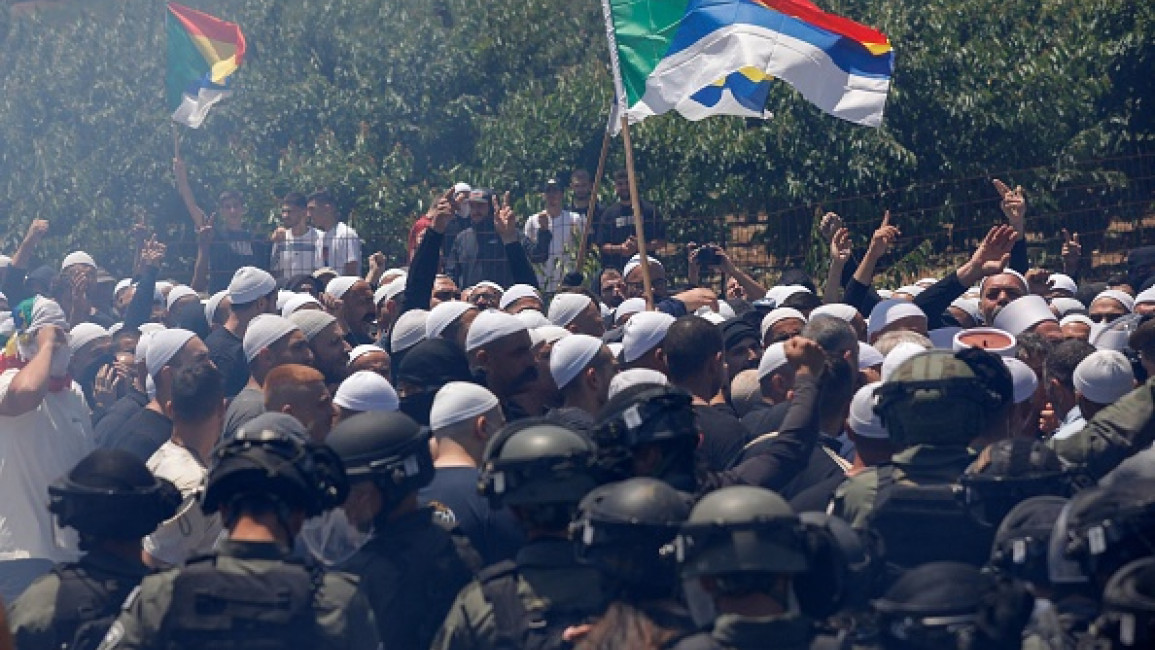Residents of occupied Golan Heights clash with Israeli forces over wind farm project
Clashes broke out on Tuesday between Israeli forces and residents of the occupied Golan Heights opposed to the construction of a wind energy project.
Hundreds of Druze Syrians from the towns of Majdal Shams, Mas’ade and Ein Qiniyye in the Israeli-occupied region rallied to defend their farmlands from the wind turbine project and confronted Israeli police.
A number of people were injured.
If implemented, the project would lead to the confiscation of 4,500 dunums – or over 1,000 acres - of agricultural land that hundreds of families rely on for their livelihood. It has been in the works for years.
Videos shared online showed residents confronting Israeli forces and blocking roads with burning tires.
اندلاع مواجهات بين أبناء #الجولان والقوات الإسرائيلية التي تمنعهم من دخول أراضيهم التي تعتزم السلطات الإسرائيلية إقامة مخطط التوربينات عليها
— Nour Abo Hasan (@nourabohsn) June 20, 2023
القوات الإسرائيلية تتطلق على أهالي الجولان وتطلق قنابل الغاز المسيل للدموع مما أدى إلى إصابات عديدة بينهم pic.twitter.com/Ld0isrkPcV
مصادر إعلامية: مواجهات بين أبناء الجولان وقوات الاحتلال الإسرائيلي التي تمنعهم من دخول أراضيهم pic.twitter.com/teALYktATk
— Newpress | نيو برس (@NewpressPs) June 20, 2023
إغلاق الطرقات والشوارع من قبل أهالي الجولان ومواجهات بين قوات الأمن الإسرائيلي وأهالي الجولان pic.twitter.com/aDTXJKvzUf
— Nour Abo Hasan (@nourabohsn) June 20, 2023
"Today they [Israeli police] entered the lands of the Golan Heights by force, against the will of the people, even when we legally objected," Sheikh Salman Awad told The New Arab’s sister site Al-Araby Al-Jadeed.
Awad said that "the majority of the Golan residents, who number 27,000, refuse the project, except for a few people."
"They entered against the will of the people of the Golan, which led to clashes," Awad told Al-Araby Al-Jadeed, confirming that there were injuries.
The Golan resident said Israeli forces had turned the area into a military zone and the situation was tense.
"They will not be able to build [wind] turbines except over our dead bodies," he said.
Residents and farmers in villages affected by the project have taken the matter to Israeli courts. Previous appeals submitted to the Jerusalem Planning and Building Committee have reportedly been rejected.
Golan resident Emile Masoud said the case was not over.
"Currently, there are 184 farmers, in addition to five agricultural associations" taking part in the case, he told Al-Araby Al-Jadeed, adding that farmers were dealing with the confiscation of their lands as a united front, not as individuals, as Israeli authorities have tried to pressure them to do.
Masoud explained that there are 18 farming associations in the Golan, the heads of whom have held several meetings since 2017 to fight against the project.
They all agree that the region will be "completely paralysed" if the Israeli government decides to go ahead with it.
"We will preserve our land, and will not abandon our Syria," he said.
Israel's quiet annexation of Golan Heights @emadmoussa analyses what the Israeli government's plan is https://t.co/irgmtjUsRD
— The New Arab (@The_NewArab) January 21, 2022
Israel captured the Golan Heights region of Syria in the 1967 Arab-Israeli war. It illegally annexed the area in 1981, in a move not recognised by most of the international community.
While its residents can claim Israeli citizenship and are subject to Israeli civil law, many had decided not to. But since the Syrian conflict erupted in 2011, some have decided to become Israeli nationals.
Israel has constructed a series of settlements and construction projects in the region to further tighten its control of the region.
The current native Golan population stands at around 27,000 people, most of them Druze. But a recent UN report said the Jewish Israeli settler population has now surpassed the native Syrian population in the occupied territory.
Only four out of the original 163 towns and villages present in the Golan before 1967 remain today: Majdal Shams, Mas’ade, Ein Qiniyye and Buq’ata, all of which are Druze majority.



